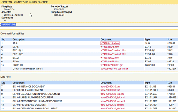Understanding XBRL
XBRL (eXtensible Business Reporting Language) is an interactive data programming language used to exchange and disseminate corporate reporting information. XBRL is XML-based, using XML syntax and other XML technologies to create unique, predefined data tags (like barcodes) identifying the information's content and structure. In the U.S., the SEC requires reporting companies to tag financial statement line items and financial notes and schedules with pre-specified taxonomies (GAAP, Mutual Funds, NRSRO, IFRS).
The SEC mandate is proposed to increase the speed at which investors will be able to manipulate and compare data across companies and industries. XBRL files are downloadable into spreadsheets, for easy manipulation of data, thereby giving more efficiencies and transparencies into the financial markets. The SEC published its final rules in 2009, requiring public companies according to size to file in XBRL.
Users of XBRL include regulators such as the Federal Deposit Insurance Corporation (FDIC), Securities and Exchange Commission (SEC), Committee of European Banking Supervisors (CEBS), and the HM Revenue & Customs (HMRC). Countries that have been mandated to use XBRL include: China, Japan, Israel, Korea, Netherlands, Singapore, Spain, and the U.S. XBRL is expected to be the global reporting and communication language by 2020.
Mandated Timeline
The SEC mandated XBRL to be filed according to company size in different stages as follows:
- Large Accelerated Filers with a public float greater than $5B were required to file XBRL starting on 6/15/2009.
- All other Large Accelerated Filers were required to file XBRL starting on 6/15/2010.
- All remaining filers were required to file XBRL starting on 6/15/2011.
1st Stage: During the first year of filing XBRL, companies were required to detail tag financial statements and block tag footnotes.
2nd Stage: In the second year of filing XBRL, companies were required to detail tag both financial statements and footnotes.
Filers |
Items |
6/15/2009 |
6/15/2010 |
6/15/2011 |
6/15/2012 |
6/15/2013 |
Large Accelerated Filers |
Financials |
Detail Tag |
||||
Footnotes |
Block Tag |
Detail Tag |
||||
All Other Large Accelerated Filers |
Financials |
Detail Tag |
||||
Footnotes |
Block Tag |
Detail Tag |
||||
All Remaining Filers |
Financials |
Detail Tag |
||||
Footnotes |
Block Tag |
Detail Tag |
To learn more about XBRL tagging requirements, click here.
Limited liability clause
Under Rule 406T, the SEC exempted filers from any liability based on the content of XBRL data for 24 months after the first submission. The limited liability provision terminated entirely as of October 31, 2014.
Required Forms
Filers are required to file all documents in HTML or ASCII, however not all forms are required to be filed in XBRL. Here is a list of the forms that are required to be filed in XBRL:
- Periodic and transition reports on Forms 10-Q, 10-K, 20-F, 40-F, 485BPOS
- Forms 8-K or 6-K that contain revised or updated financial statements
- Restatements
- Securities Act registration statements (not IPOs) that contain financial statements
Here is a full list of form types that can be filed in XBRL:
- Corporate Filers: 10, 10-K, 10-Q, 20-F, 40-F, 6-K, 8-K, F-1, F-10, F-3, F-4, F-9, S-1, S-11, S-3, S-4, POS AM, 10-KT, 10-QT, POS EX, 10/A, 10-K/A, 10-Q/A, 20-F/A, 40-F/A, 6-K/A, 8-K/A, F-1/A, F-10/A, F-3/A, F-4/A, F-9/A, S-1/A, S-11/A, S-3/A, S-4/A, 10-KT/A, 10-QT/A
- Investment Management Filers: 485BPOS, 497, N-CSR, N-CSRS, N-Q, N-CSR/A, N-CSRS/A, N-Q/A
See also: SEC Release 33-9002, The required filings disclosure can be found on pages 65-69 (Section II, B, 3- b, c, and d). You may need to consult your attorney for specific exemptions.
Filing Overview
XBRL is based on XML code (as seen below) that pulls data from multiple taxonomy subcategories and submission information to comprise instance documents, taxonomy schemas and linkbases, which are all put together to comprise one XBRL filing submission.

- Filing Creation: To initiate the filing process, our XBRL team extracts your financials and notes to financials from your last HTML filing or latest Excel or Word document. After extraction, each category line item in the financials will then be detail tagged with references to period dates, units, and taxonomy line item categories. After financials have been tagged, the notes to financials will need to be either block tagged or detail tagged.
- Review: Once a taxonomy for a company has been created and mapped, it is submitted to the company for review. The company can then approve or reject each line item that has been tagged. At this time, it is important to ask questions about selections of tags that you are unsure about. Once all of the items have been approved, the filing can then be previewed on the SEC's XBRL viewer website before filing.
- Submission: XBRL files are attached as exhibits to the HTML submission and submitted simultaneously with the HTML files to the SEC.
Below is a sample of how the documents will appear on the SEC website (click to enlarge):

Website Posting
Interactive data and XBRL files must be posted to the corporate website the earlier of the end of the calendar day submitted or the required filing deadline, whichever comes sooner. This data must be posted on the corporate website for 1 year.
Contact a sales representative to obtain a quote or learn more about our XBRL filing services at 877-285-8605.




